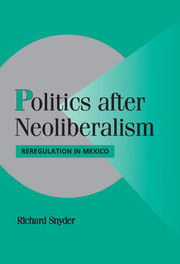7 - AFTER NEOLIBERALISM: WHAT NEXT?
Published online by Cambridge University Press: 03 December 2009
Summary
Neoliberal policy reforms result in different kinds of new institutions for market governance, not in the triumph of free-market forces. That is the main finding of this study. This finding challenges the expectations of both the supporters and the opponents of neoliberal policies, who share the assumption that, for better or worse, these policies result in a convergence on unregulated markets. The evidence analyzed in this study shows instead that neoliberal reforms unleash a new round of politics – the politics of reregulation. As we have seen, the politics of reregulation leads to varying institutions for market governance with contrasting consequences for economic efficiency and social justice.
Neoliberal shocks create institutional vacuums, a situation that gives political entrepreneurs opportunities to reregulate sectors of the economy. Politicians seize these opportunities because reregulation generates divisible benefits and targetable rewards that help them gain and keep power. Societal groups also have a stake in how markets are reregulated, and politicians' reregulation projects can give them compelling incentives to mobilize. Hence, reregulation is a political process in which politicians and societal groups bargain over the rules of new institutions for market governance that replace those destroyed by neoliberal reforms. The relative strengths and strategies of politicians and societal groups who participate in this bargaining determine the distinct institutional outcomes of reregulation.
To cast this argument in a systematic form, in Chapter 1 I proposed a framework for analyzing the politics of reregulation. The framework consists of two steps with a dual focus on politicians' choices of reregulation projects and on subsequent strategic interactions between politicians and societal groups regarding the terms of reregulation.
- Type
- Chapter
- Information
- Politics after NeoliberalismReregulation in Mexico, pp. 195 - 218Publisher: Cambridge University PressPrint publication year: 2001



